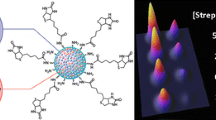Abstract
Aminosilane-treated molecular layers on glass surfaces are frequently used as functional platforms for biosensor preparation. All the amino groups present on the surface are not available in reactive forms, because surface amino groups interact with remaining unreacted surface silanol groups. Such nonspecific interactions might reduce the efficiency of chemical immobilization of biomolecules such as DNA, enzymes, antibodies, etc., in biosensor fabrication. To improve immobilization efficiency we have used additional surface silanization with alkylsilane (capping) to convert the remaining silanol groups into Si–O–Si linkages, thereby liberating the amino groups from nonspecific interaction with the silanol groups. We prepared different types of capped amine surface and evaluated the effect of capping on immobilization efficiency by investigating the fluorescence intensity of Cy3-NHS (N-hydroxysuccinimide) dye that reacted with amino groups. The results indicate that most of the capped amine surfaces resulted in enhanced efficiency of immobilization of Cy3-NHS compared with the untreated control amine surface. We found a trend that trialkoxysilanes had greater capping effects on immobilization efficiency than monoalkoxysilanes. It was also found that the aliphatic chain of alkylsilane, which does not participate in the capping of the silanol, had an important function in enhancing immobilization efficiency. These results would be useful for preparation of an amine-modified surface platform, with enhanced immobilization efficiency, which is essential for developing many kinds of biosensors on a silica matrix.

Enhancement of amine funtionality by capping with alkylsilane





Similar content being viewed by others
References
Kinkel JN, Anspach B, Unger KK, Brunnerg RW (1984) J Chromatogr 297:167–177
Wonnacott DM, Patton EV (1987) J Chromatogr 389:103–113
Leyden DE, Luttrell GH (1975) Anal Chem 47:1612–1617
Chiang C, Ishida H, Koenig JL (1980) J Colloid Interface Sci 74:396–404
Oh SJ, Cho SJ, Kim CO, Park JW (2002) Langmuir 18:1764 –1769
Chrisey LA, Lee GU, O’Ferrall CE (1996) Nucl Acids Res 24:3031–3039
Köhler J, Chase DB, Farlee RD, Vega AJ, Kirkland JJ (1986) J Chromatogr 352:275–305
Rochester CH, Yong GH (1980) J Chem Soc Faraday Trans I 176:1158
Kiselev AV, Kulichenko VV (1953) Dokl Akad Nauk SSSR 93:101
Bartell FE, Dobay DG (1950) J Am Chem Soc 72:4388–4393
Child MJ, Heywood MJ, Yong GK (1982) J Chem Soc Faraday Trans I 178:2005
Zhang F, Srinivasan MP (2004) Langmuir 20:2309–2314
White LD, Tripp CP (2000) J Colloid Interface Sci 227:237–243
Jay JS, Christopher JM, Yang GR, Lu TM (2002) Langmuir 18:1587–1594
Kallury KMR, Krull UJ, Thompson M (1988) Anal Chem 60:169–172
Devaraj NK, Miller GP, Ebina W, Kakaradov B, Collman JP, Kool ET, Chidesy CED (2005) J Am Chem Soc 127:8600–8601
Nonglaton G, Benitez IO, Guisle I, Pipelier M, Leger J, Dubreuil D, Tellier T, Thalham DR, Bujoli B (2004) J Am Chem Soc 126:1497–1502
Pirri G, Damin F, Chiari M, Bontempi E, Depero LE (2004) Anal Chem 76:1352–1358
Hong BJ, Oh SJ, Youn TO, Kwon SH, Park JW (2005) Langmuir 21:4257–4261
Acknowledgements
This work is partially supported by Grants-in-Aid for Scientific Research from the Ministry of Education, Culture, Sports, Science, and Technology, Japan, to K.M. (no. 18350083) and by Grants-in-Aid for Regional Science and Technology Promotion “Kyoto Nanotechnology Cluster” project from the Ministry of Education, Culture, Sports, Science and Technology, Japan. This Work was also supported by CREST of the Japan Science and Technology Agency. We also thank Yasuko Yoshida and Kazunari Yamada (NGK Insulators, Ltd, Geneshot Project, Japan) for providing the ink jet spotter and the image scanner for acquiring quantitative fluorescence data.
Author information
Authors and Affiliations
Corresponding author
Rights and permissions
About this article
Cite this article
Kamisetty, N.K., Pack, S.P., Nonogawa, M. et al. Development of an efficient amine-functionalized glass platform by additional silanization treatment with alkylsilane. Anal Bioanal Chem 386, 1649–1655 (2006). https://doi.org/10.1007/s00216-006-0741-6
Received:
Revised:
Accepted:
Published:
Issue Date:
DOI: https://doi.org/10.1007/s00216-006-0741-6




